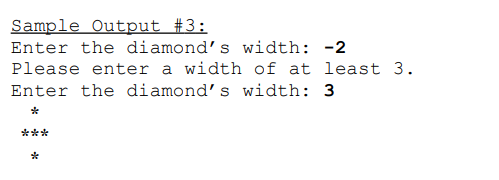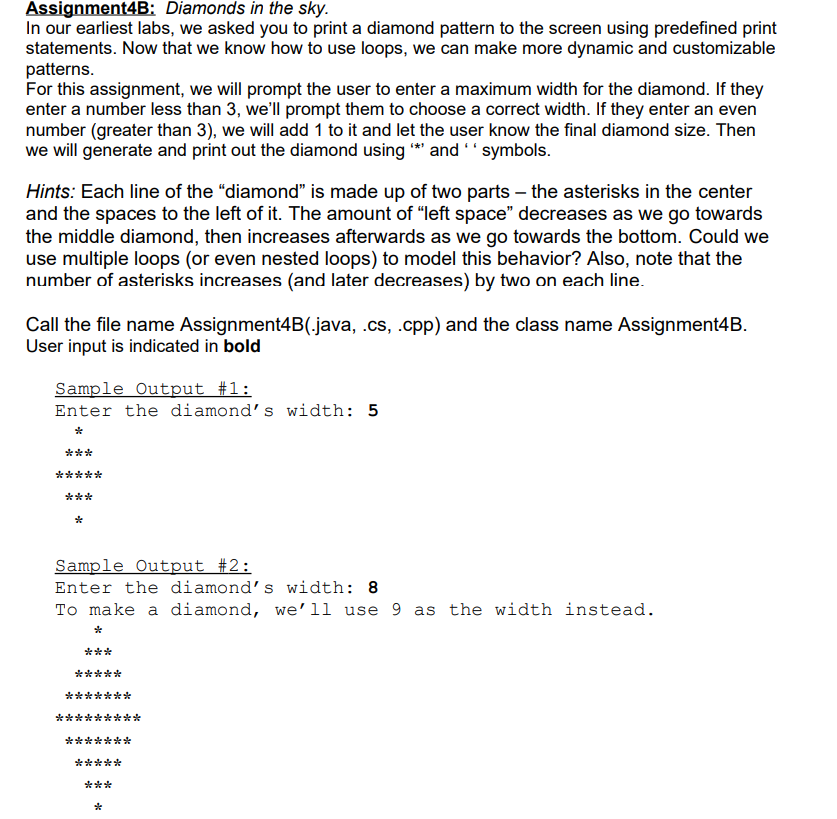In our earliest labs, we asked you to print a diamond pattern to the screen using predefined print statements. Now that we know how to use loops, we can make more dynamic and customizable patterns. For this assignment, we will prompt the user to enter a maximum width for the diamond. If they enter a number less than 3, we'll prompt them to choose a correct width. If they enter an even number (greater than 3), we will add 1 to it and let the user know the final diamond size. Then we will generate and print out the diamond using ** and '´ symbols. Hints: Each line of the "diamond" is made up of two parts – the asterisks in the center and the spaces to the left of it. The amount of "left space" decreases as we go towards the middle diamond, then increases afterwards as we go towards the bottom. Could we use multiple loops (or even nested loops) to model this behavior? Also, note that the number of asterisks increases (and later decreases) by two on each line.
In our earliest labs, we asked you to print a diamond pattern to the screen using predefined print statements. Now that we know how to use loops, we can make more dynamic and customizable patterns. For this assignment, we will prompt the user to enter a maximum width for the diamond. If they enter a number less than 3, we'll prompt them to choose a correct width. If they enter an even number (greater than 3), we will add 1 to it and let the user know the final diamond size. Then we will generate and print out the diamond using ** and '´ symbols. Hints: Each line of the "diamond" is made up of two parts – the asterisks in the center and the spaces to the left of it. The amount of "left space" decreases as we go towards the middle diamond, then increases afterwards as we go towards the bottom. Could we use multiple loops (or even nested loops) to model this behavior? Also, note that the number of asterisks increases (and later decreases) by two on each line.
Chapter6: Looping
Section: Chapter Questions
Problem 2GZ
Related questions
Question
coding language c++

Transcribed Image Text:Sample Output #3:
Enter the diamond’s width: -2
Please enter a width of at least 3.
Enter the diamond’s width: 3
***

Transcribed Image Text:Assignment4B: Diamonds in the sky.
In our earliest labs, we asked you to print a diamond pattern to the screen using predefined print
statements. Now that we know how to use loops, we can make more dynamic and customizable
patterns.
For this assignment, we will prompt the user to enter a maximum width for the diamond. If they
enter a number less than 3, we'll prompt them to choose a correct width. If they enter an even
number (greater than 3), we will add 1 to it and let the user know the final diamond size. Then
we will generate and print out the diamond using * and '' symbols.
Hints: Each line of the "diamond" is made up of two parts – the asterisks in the center
and the spaces to the left of it. The amount of "left space" decreases as we go towards
the middle diamond, then increases afterwards as we go towards the bottom. Could we
use multiple loops (or even nested loops) to model this behavior? Also, note that the
number of asterisks increases (and later decreases) by two on each line.
Call the file name Assignment4B(.java, .cs, .cpp) and the class name Assignment4B.
User input is indicated in bold
Sample Output #1:
Enter the diamond's width: 5
***
*****
***
Sample Output #2:
Enter the diamond’s width: 8
To make a diamond, we'll use 9 as the width instead.
*
***
*****
*******
**
***
*******
*****
***
Expert Solution
This question has been solved!
Explore an expertly crafted, step-by-step solution for a thorough understanding of key concepts.
This is a popular solution!
Trending now
This is a popular solution!
Step by step
Solved in 2 steps with 2 images

Recommended textbooks for you

EBK JAVA PROGRAMMING
Computer Science
ISBN:
9781337671385
Author:
FARRELL
Publisher:
CENGAGE LEARNING - CONSIGNMENT

Programming Logic & Design Comprehensive
Computer Science
ISBN:
9781337669405
Author:
FARRELL
Publisher:
Cengage

EBK JAVA PROGRAMMING
Computer Science
ISBN:
9781337671385
Author:
FARRELL
Publisher:
CENGAGE LEARNING - CONSIGNMENT

Programming Logic & Design Comprehensive
Computer Science
ISBN:
9781337669405
Author:
FARRELL
Publisher:
Cengage